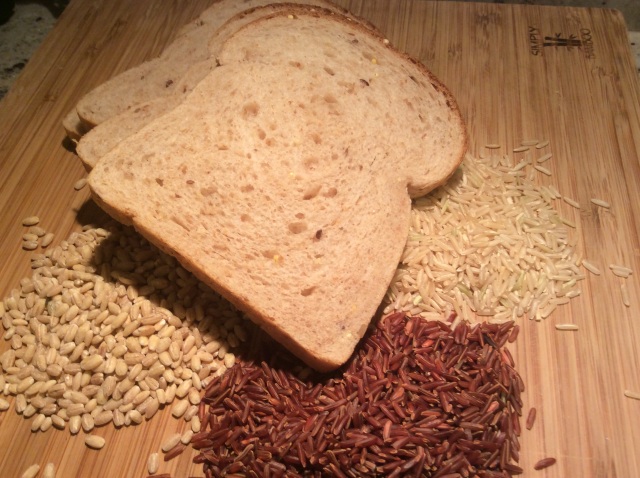In the last post, “Putting the “whole” back into grains”, we looked at the numerous health benefits that “premium carbs” aka high quality carbohydrates, bring to the table. Let’s now look at what it takes to bring these foods to our kitchen tables literally, as we continue to shine the spotlight on whole grains and fiber.

Clockwise: Whole grains from red rice, barley,whole wheat bread and brown rice © Copyright 2015 Sangeeta Pradhan, RD, LDN, CDE.
From the research to the grocery aisle:

Look for the whole grain stamp, but also check out the Nutrition Facts label. © Copyright 2015 Sangeeta Pradhan, RD, LDN, CDE
How do I spot whole grains?: Look for the 100% whole grain stamp on food products. This means that all the grains in the product are whole, and it contains a minimum of 16 grams (1 serving) of whole grain. That said, beware of products that may have whole grains, but which may be laced with sugar or high fructose corn syrup for increased palatability and shelf-life.
The 2010 Dietary guidelines: These guidelines recommend approximately 14 grams of fiber per 1000 calories, or 25 grams of fiber per day for women and 38 grams per day for men. Hence, although you may come across products that are “whole grain”, the fiber may not necessarily stack up. Fiber has been identified as a “shortfall” nutrient with the average American consuming a shockingly low 15 grams per day. This could be related to the over-consumption of refined grains from breads, rolls, pizza etc that are abundant in our nation’s food supply and thus more easily accessible. (1)
Given the health benefits of fiber and whole grains, (2),(3),(4), it stands to reason to increase our intake of both.
Get the facts: Look at the “Nutrition Facts” label and make sure that your foods meet the following criteria:

“Multi-grain” and “12 grain” are misleading terms and may not indicate a whole grain. Check out the fiber content too. © Copyright 2015 Sangeeta Pradhan, RD, LDN, CDE
- Choose whole grain cereals with at least 6 grams of fiber and no more than 6 grams of sugar per serving.
- Choose breads with 100% whole grains and at least 3-5 grams of fiber per slice.
- All in a day’s work: Here are a few every-day foods that will help you reach your daily whole grain and fiber goal relatively easily:
- 1/2 a cup of cooked oatmeal or a serving of shredded wheat at breakfast can give you 6 grams of fiber ( 1 whole grain serving), a whole grain sandwich at lunch ( 2 whole grains) and 6 grams of fiber, 1 cup of barley at dinner ( 3 whole grains) and 6 grams of fiber. That’s 18 grams of fiber, and 6 whole grain servings, so if you toss a 1/2 cup of chickpeas or black beans (8 hefty grams of fiber) into your salad at dinner, munch on an apple (4 grams of fiber) at lunch, and mix a cup of raspberries (8 grams of fiber) with your yogurt for a snack, you have hit your daily goal of 38 grams of fiber, not to mention whole grain target even before including the broccoli (5 grams per serving) that you ate at dinner!
- Because of fiber’s water holding capacity, it can act like a sponge, sucking up water as it transits through your digestive track, so make sure you drink lots of water to compensate, and add the fiber gradually to allow your body to get used to it. An abrupt increase in fiber may lead to flatulence, diarrhea and other adverse GI side effects.
Go with the grain! : Getting your whole grains and meeting you fiber goal can be a cinch once you understand these basic rules of thumb. More importantly, you do not have to break the bank or scour the internet looking for these foods. If they are not already in your kitchen cabinets, you should find them at your local grocery store, now that you have started to unravel the puzzle! Stay tuned for much, much more on the “Whole truth” on carbs in the coming weeks!

Whole grain shredded wheat with 1/2 a cup of strawberries packs a delicious 8 grams of fiber. © Copyright 2015, Sangeeta Pradhan, RD, LDN, CDE















































Thanks! This is highly informative.
LikeLiked by 1 person
You are more than welcome! And thank you for the kind words😊!
LikeLike
Pingback: Massachusetts Academy of Nutrition and Dietetics - About MAND